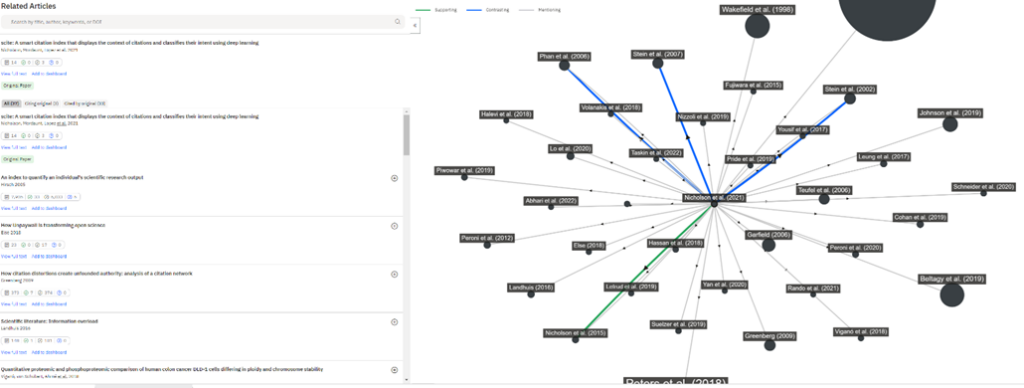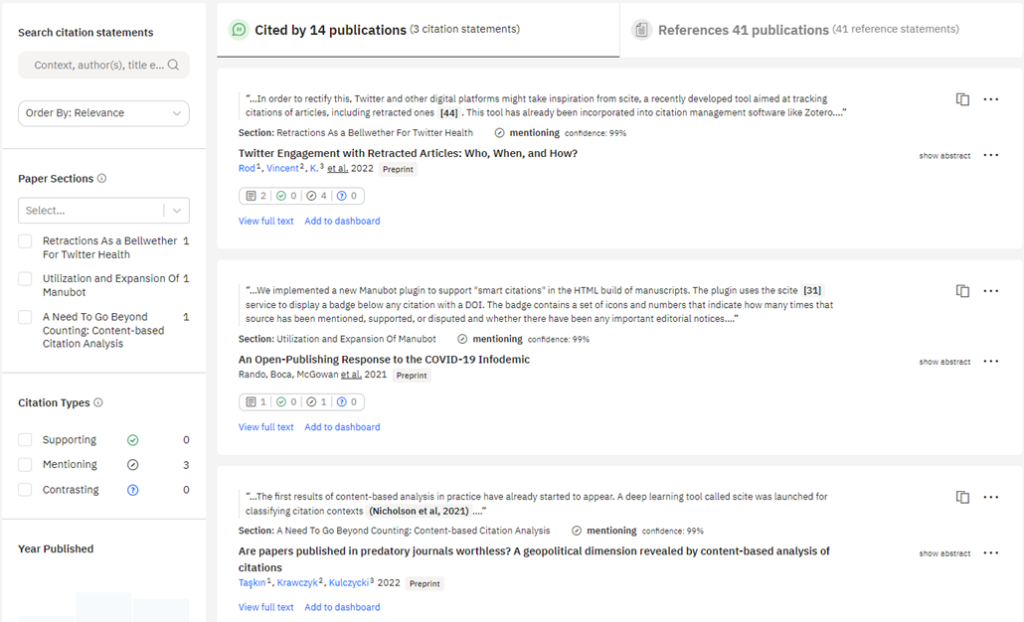If you aim to conduct scientific research or some other research project, Scite is a very useful tool for this type of work. Thanks to it, you can discover, understand, examine, and evaluate the existing literature quickly and effectively to facilitate the review process and information analysis.
This artificial intelligence tool offers a qualitative or quantitative perspective on how scientific publications are cited.
How does it work?
Scite employs a deep learning model to produce Smart Citations, which provide information about how often researchers cite an article and how they cite it, for example, to support or compare evidence or only to mention the source. Here’s a quick explanation of how this process works.
Scite comprises a database with Smart Citations, integrated by an extensive collection of files collected by indexing agreements with several publishers (Wiley, Cambridge, University Press, etc.) and repository sources of scientific preprints, such as arXiv, bioRxiv, and medRxiv. To know more about Scite’s sources and metadata, click here.
But how are Smart Citations created? According to Nicholson et al. (2021), these citations are made by analyzing and extracting citation statements, that is, the context of the text surrounding the quotation. Producing them follows the sequence below (Nicholson et al., 2021):
- Recovery of scientific articles.
- Identification and matching of citations and references within an article.
- Comparison of references with a database.
- Classification of references using a deep learning model.
How are citations classified?
The classification of references using a deep learning model can comprise three categories: contrasting (comparing), supporting, or mentioning.

This image shows how Scite classifies citations. A green symbol indicates supporting ideas, black represents mentioning, and blue reveals contrasting.
Additionally, unclassified references fall outside the deep learning model’s program for the three classifications (support, mention, and contrast).
Functions of Scite
This platform has several interesting functions, including the following highlights:
- Report page: displays how other people have cited a particular publication. Thanks to this report, you can find publications of interest, discover other publications that refer to the one you mention, and find correlations among them. You can also see the citational context to know if the information is contrasting or supportive and synthesize the publications to define whether they are reliable.
- Reference Check: Allows uploading a document to see how references have been cited by others and if any have been removed or if they have editorial comments. Notably, the information stored when you upload a PDF and get a report from Reference Check includes the following: title, metadata, references used, and the citation statements of each reference.
- Advanced Search: Facilitates searching topics with the ability to screen information about how well supported or contrasted are the arguments and evidence of the articles.
- Custom boards: allow adding information about groups of items, depending on the DOI provided, and monitoring them. You can construct a dashboard by importing data from Zotero or Mendeley.
- Zotero Plugin: supports Scite in your bibliographic reference manager (library).
- Browser extension: is a browser version of Scite. In addition, it shows how the publications have been cited and whether these citations are supporting, mentioning, or contrasting. This extension also facilitates Scite’s Assistant to consult information. Its other functions include the option to display the Scite emblems with relevant information in reference lists, search results, Google Scholar, and PubMed, among others.
Scite’s Assistant language model is a “ChatGPT” for researchers. The specialized functions of this chatbot are for those who conduct research or write publications; it is equally powerful as, for example, GPT 3, but for science.
As an example, we use the article by Nicholson et al. (2021), “Scite: A smart citation index that displays the context of citations and classifies their intent using deep learning,” to show how Scite displays particular functions:



Benefits
- Speeds up information analysis and literature reviews.
- Graphically displays how and by whom a publication has been cited.
- Discovers authors, literature, and publications, among others, relevant to your interest.
- Contains a browser extension and a specialized ChatGPT.
- Has an effective classification model for a publication’s focus of interest.
- Periodically updates its products and services to provide the best experience.
Considerations

Although Scite only comprises 880 million citation statements from 25 million publications, its cumulative information keeps growing thanks to its continuous updating (Nicholson et al., 2021).
Notably, Scite has a trial period of seven days; thus, it is not a free tool, and its monthly or annual costs depend on what is required. However, the tool’s cost-benefit has an exceptional functional balance.
Lastly, it is noteworthy that Scite periodically updates its products; it is not a static platform lacking functionalities development.
Scientific research advances knowledge, problem-solving, society, human development, and well-being. Thus, this artificial intelligence tool is a valuable resource for students and researchers because it facilitates research processes and allows the discovery of more scientific literature to complement an investigation or help understand a complex topic.
This type of AI is relevant for today’s world, given that, according to the UNESCO Science Report (n.d.), the number of researchers increased to 8,854 million worldwide in 2018. However, although this number is overwhelming, the participation of women in research was only 33% (United Nations, 2023), so this consideration indicates still a long way to go.
The automation and convenience provided by AI, which can be seen as programs to perform specific cognitive processes, must be used properly. They are not tools to replace our skills, critical thinking, or logical reasoning. Nevertheless, Scite is a functional tool to meet the needs of twenty-first-century researchers.
References:
Nicholson, J., Mordaunt, M., Lopez, P., Uppala, A., Rosati, D., Rodrigues, N., Grabitz, P. & Rife, C. (2021). Scite: A smart citation index that displays the context of citations and classifies their intent using deep learning. Quantitative Science Studies. 2(3): 882–898.
UNESCO. (n.d.). Estadísticas y recursos. UNESCO. https://www.unesco.org/reports/science/2021/es/statistics#:~:text=Este%20aumento%20hizo%20que%20en,se%20cifrara%20en%208.854%20millones
United Nations. (10 February 2023). More participation of women and girls = better science, technology, engineering, and mathematics. United Nations. https://news.un.org/es/story/2023/02/1518507
This article from Observatory of the Institute for the Future of Education may be shared under the terms of the license CC BY-NC-SA 4.0 
)
)


)